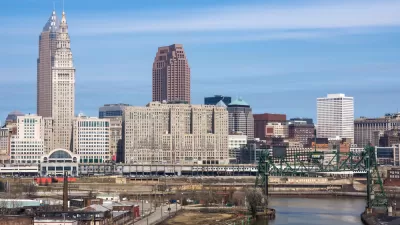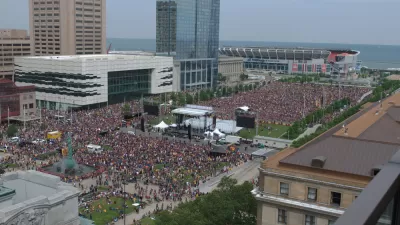WBUR's Here & Now ventures outside the Quicken Loans Arena to see a distressed part of the city and region, similar to parts of Detroit and Flint. Residents want abandoned homes demolished. Take the audio driving tour of East Cleveland.
"A new study* from the Economic Innovation Group, an advocacy group, named Cleveland the most distressed large city in the U.S.," states the introduction to the audio tour. "Thirteen percent of housing in this city is vacant," states Here & Now's Robin Young.
The tour starts off in a very attractive part of the city known as University Circle, home to Case Western University, many museums and other attractions. It goes downhill (figuratively) from there as the tour proceeds.
"The foreclosure crisis did a real number on this part of the country," states Rokakis, resulting in an 18 percent population loss in the city. "The only city that lost more people, percentage-wise, was Detroit."
To see a comparison of population loss with other large cities dating back to 1950 that lost at least 20 percent of their population, see Wikipedia's "Shrinking cities." Cleveland ranks #4 at 56.6 percent after St. Louis, Detroit and Youngstown, Ohio.
The first problem Rokakis tells Young is that funds from the state's foreclosure relief program are restricted to single family buildings, "and as we will see, part of Cleveland's blight are old, abandoned brick apartment buildings," states Young. "Another problem, there are people who don't want demolition."
Driving down Euclid Avenue, once described as 'millionaire's row' in the documentary below, past a 'vibrant, booming neighborhood,' they cross a bridge into East Cleveland, "one of the most distressed communities in the state of Ohio, a city in 'fiscal emergency...for almost a generation now'", states Rokakis. "And now we'll see some of the worst blight you'll see."
Both describe the buildings they see in great detail, because unlike typical blight, they can still see the architecturally beautiful and historic aspects of the homes. They discuss the civic debate that is occurring over these buildings: do they rehabilitate or demolish? Rokakis' expertise also shows itself in their discussion.
The overwhelming sentiment of people in those neighborhoods is, "how soon can you take that property down?" states Rokakis.
When these buildings don't pay property taxes, it creates a greater burden on the communities where properties are being paid.
They drive by one section of East Cleveland that has been completely abandoned. "My gosh, look at this," gasps Young. "This is breathtaking."
"This is America, it is not a third world country," adds Rokakis.
Listen to the 7-minute audio. Young holds nothing back. And check out the pictures.
More interested? See the documentary, 'Cleveland: Confronting Decline in an American City' on Planetizen.
Thanks to the good work of Rokakis and the non-profit Thriving Communities Institute, "Cleveland is getting a better hand on understanding its stock of vacant homes that litter parts of the city," wrote Planetizen correspondent Josh Williams last December.
Here's the good news: The blight isn't as bad as it appeared, based on past estimates from the city and other researchers…
* Richard Florida evaluates the Economic Innovation Group's report for CityLab last May.
FULL STORY: Looking At Blight In East Cleveland, A City Hit Hard By The Housing Crisis

Alabama: Trump Terminates Settlements for Black Communities Harmed By Raw Sewage
Trump deemed the landmark civil rights agreement “illegal DEI and environmental justice policy.”

Planetizen Federal Action Tracker
A weekly monitor of how Trump’s orders and actions are impacting planners and planning in America.

The 120 Year Old Tiny Home Villages That Sheltered San Francisco’s Earthquake Refugees
More than a century ago, San Francisco mobilized to house thousands of residents displaced by the 1906 earthquake. Could their strategy offer a model for the present?

Indy Neighborhood Group Builds Temporary Multi-Use Path
Community members, aided in part by funding from the city, repurposed a vehicle lane to create a protected bike and pedestrian path for the summer season.

Congestion Pricing Drops Holland Tunnel Delays by 65 Percent
New York City’s contentious tolling program has yielded improved traffic and roughly $100 million in revenue for the MTA.

In Both Crashes and Crime, Public Transportation is Far Safer than Driving
Contrary to popular assumptions, public transportation has far lower crash and crime rates than automobile travel. For safer communities, improve and encourage transit travel.
Urban Design for Planners 1: Software Tools
This six-course series explores essential urban design concepts using open source software and equips planners with the tools they need to participate fully in the urban design process.
Planning for Universal Design
Learn the tools for implementing Universal Design in planning regulations.
Clanton & Associates, Inc.
Jessamine County Fiscal Court
Institute for Housing and Urban Development Studies (IHS)
City of Grandview
Harvard GSD Executive Education
Toledo-Lucas County Plan Commissions
Salt Lake City
NYU Wagner Graduate School of Public Service




























